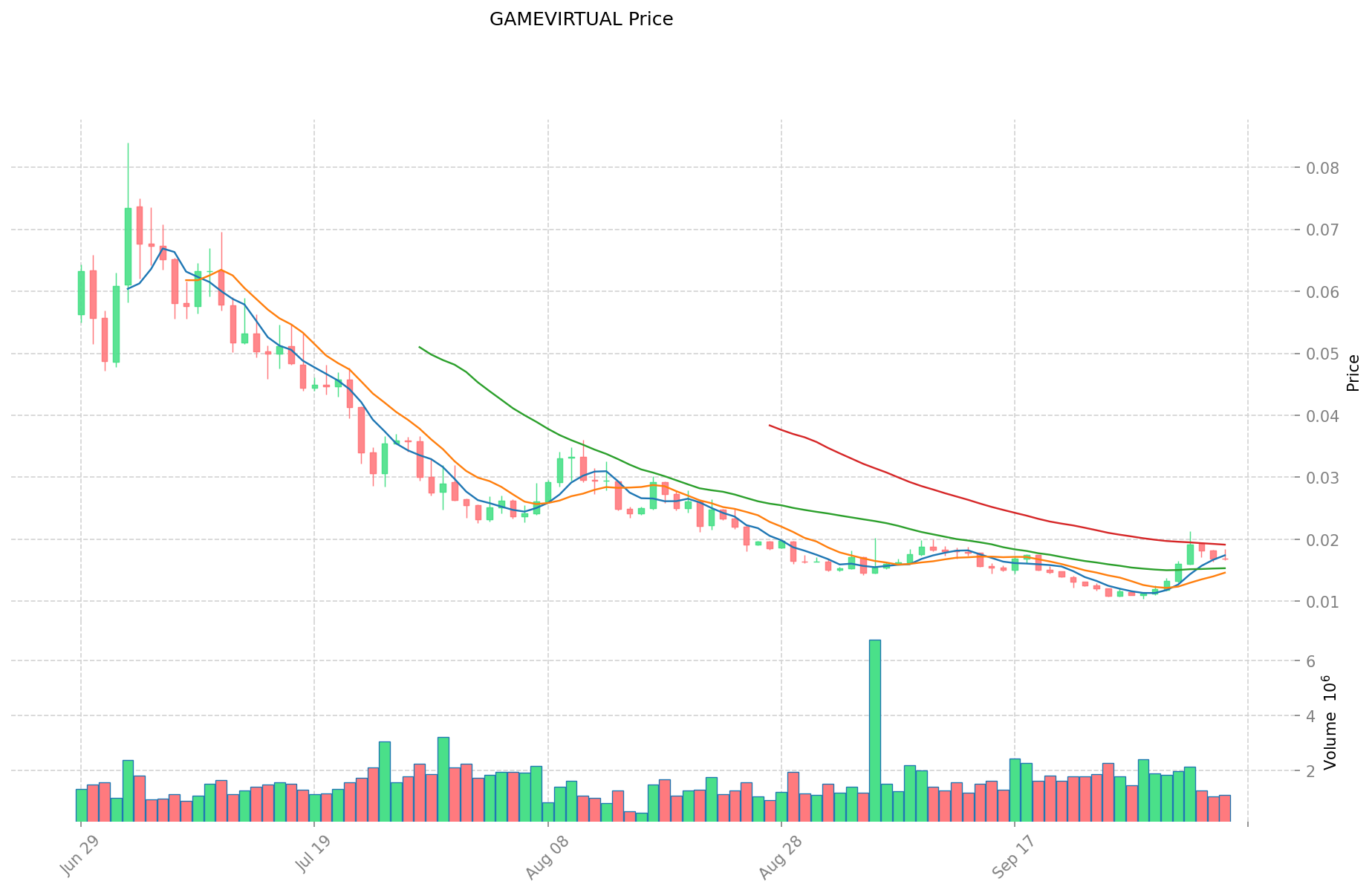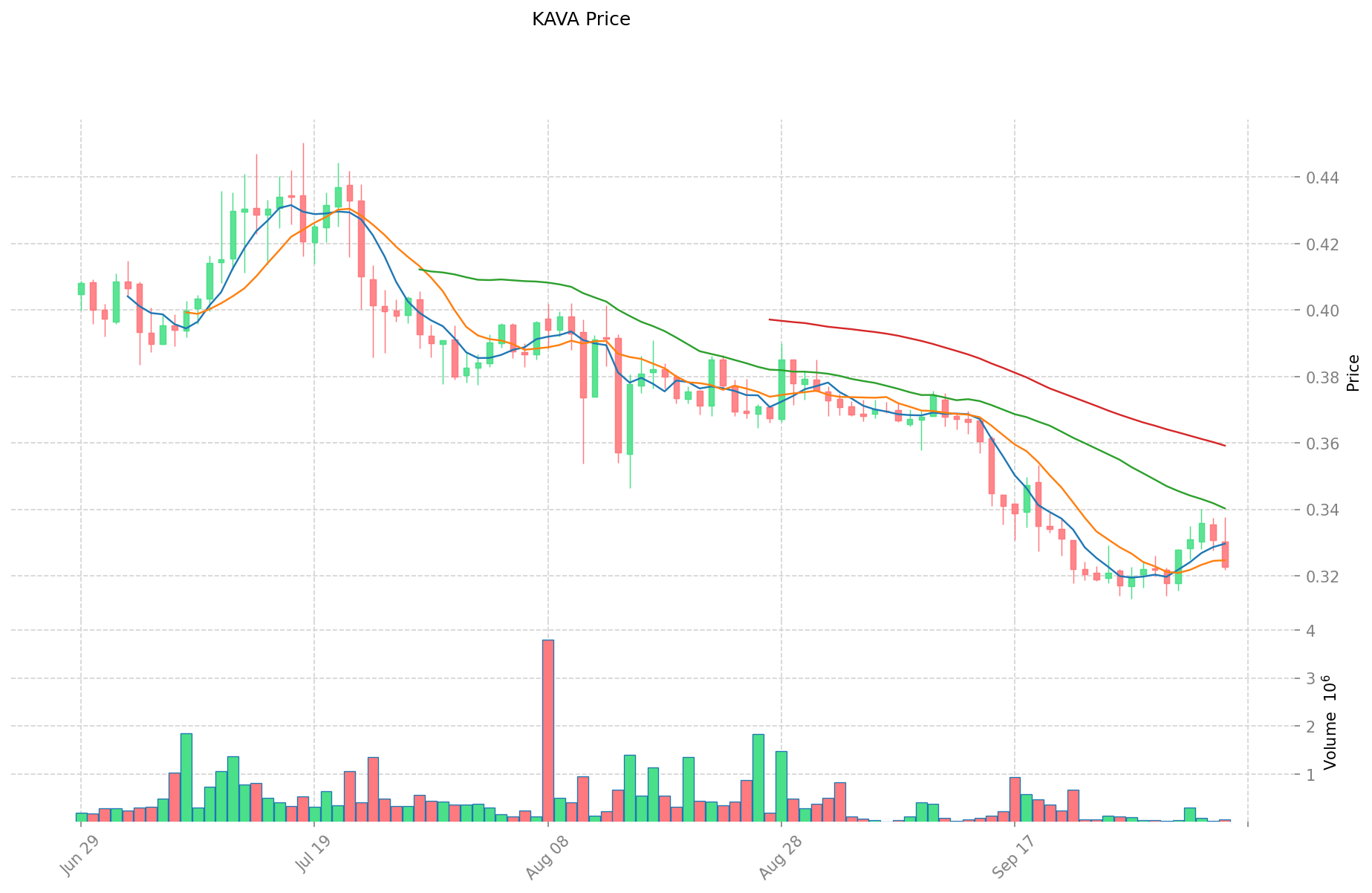GAMEVIRTUAL vs KAVA: Comparing Two Leading Blockchain Gaming Platforms in the Expanding Metaverse Economy
Introduction: GAMEVIRTUAL vs KAVA Investment Comparison
In the cryptocurrency market, the comparison between GAMEVIRTUAL vs KAVA has been an unavoidable topic for investors. The two not only show significant differences in market cap ranking, application scenarios, and price performance but also represent different positioning in the crypto asset space.
GAMEVIRTUAL (GAMEVIRTUAL): Since its launch, it has gained market recognition for its blockchain-based crowdfunding platform for independent game developers.
KAVA (KAVA): Introduced in 2019, it has been hailed as a cross-chain decentralized finance platform, providing mortgage and stablecoin services for mainstream digital assets.
This article will comprehensively analyze the investment value comparison between GAMEVIRTUAL and KAVA, focusing on historical price trends, supply mechanisms, institutional adoption, technological ecosystems, and future predictions, attempting to answer the question most concerning to investors:
"Which is the better buy right now?"
I. Price History Comparison and Current Market Status
GAMEVIRTUAL (Coin A) and KAVA (Coin B) Historical Price Trends
- 2024: GAMEVIRTUAL reached its all-time high of $0.715 on December 27, 2024.
- 2021: KAVA hit its all-time high of $9.12 on August 30, 2021.
- Comparative analysis: In recent market cycles, GAMEVIRTUAL dropped from its high of $0.715 to a low of $0.0095, while KAVA fell from $9.12 to $0.247359.
Current Market Situation (2025-10-06)
- GAMEVIRTUAL current price: $0.01676
- KAVA current price: $0.3212
- 24-hour trading volume: GAMEVIRTUAL $19,407.37 vs KAVA $17,455.27
- Market Sentiment Index (Fear & Greed Index): 74 (Greed)
Click to view real-time prices:
- Check GAMEVIRTUAL current price Market Price
- Check KAVA current price Market Price


II. Core Factors Influencing KAVA's Investment Value
Supply Mechanism (Tokenomics)
- KAVA: The tokenomics includes staking mechanisms that influence circulating supply dynamics
- 📌 Historical Pattern: Supply mechanisms drive price cycle changes through staking rewards and governance participation.
Institutional Adoption and Market Applications
- Institutional Holdings: KAVA has been gaining traction among certain institutions
- Enterprise Adoption: KAVA's applications in cross-border payments, settlement, and investment portfolios
- National Policies: Regulatory attitudes toward KAVA vary significantly across jurisdictions
Technology Development and Ecosystem Building
- KAVA Technical Upgrades: Integration capabilities with multiple blockchain protocols
- Ecosystem Comparison: Growing DeFi applications, smart contract implementation, and payment solutions
Macroeconomic and Market Cycles
- Performance in Inflationary Environments: KAVA's potential as an inflation hedge
- Macroeconomic Monetary Policy: Impact of interest rates and USD index on KAVA
- Geopolitical Factors: Cross-border transaction demands and international situations affecting adoption
III. 2025-2030 Price Prediction: GAMEVIRTUAL vs KAVA
Short-term Prediction (2025)
- GAMEVIRTUAL: Conservative $0.010188 - $0.01698 | Optimistic $0.01698 - $0.0188478
- KAVA: Conservative $0.248787 - $0.3231 | Optimistic $0.3231 - $0.445878
Mid-term Prediction (2027)
- GAMEVIRTUAL may enter a growth phase, with expected price range of $0.01781358216 - $0.02692280031
- KAVA may enter a bullish market, with expected price range of $0.2465727957 - $0.6466720491
- Key drivers: Institutional capital inflow, ETF, ecosystem development
Long-term Prediction (2030)
- GAMEVIRTUAL: Base scenario $0.03464542339456 - $0.040535145371635 | Optimistic scenario $0.040535145371635+
- KAVA: Base scenario $0.728866799776788 - $0.962104175705361 | Optimistic scenario $0.962104175705361+
Disclaimer: These predictions are based on historical data and market analysis. Cryptocurrency markets are highly volatile and subject to rapid changes. This information should not be considered as financial advice. Always conduct your own research before making investment decisions.
GAMEVIRTUAL:
| 年份 | 预测最高价 | 预测平均价格 | 预测最低价 | 涨跌幅 |
|---|---|---|---|---|
| 2025 | 0.0188478 | 0.01698 | 0.010188 | 1 |
| 2026 | 0.022571514 | 0.0179139 | 0.012360591 | 6 |
| 2027 | 0.02692280031 | 0.020242707 | 0.01781358216 | 20 |
| 2028 | 0.0320725449708 | 0.023582753655 | 0.0127346869737 | 40 |
| 2029 | 0.041463197476221 | 0.0278276493129 | 0.024210054902223 | 66 |
| 2030 | 0.040535145371635 | 0.03464542339456 | 0.022865979440409 | 106 |
KAVA:
| 年份 | 预测最高价 | 预测平均价格 | 预测最低价 | 涨跌幅 |
|---|---|---|---|---|
| 2025 | 0.445878 | 0.3231 | 0.248787 | 0 |
| 2026 | 0.54597438 | 0.384489 | 0.20377917 | 19 |
| 2027 | 0.6466720491 | 0.46523169 | 0.2465727957 | 44 |
| 2028 | 0.7171779117195 | 0.55595186955 | 0.3168925656435 | 73 |
| 2029 | 0.821168708918827 | 0.63656489063475 | 0.541080157039537 | 98 |
| 2030 | 0.962104175705361 | 0.728866799776788 | 0.699712127785717 | 126 |
IV. Investment Strategy Comparison: GAMEVIRTUAL vs KAVA
Long-term vs Short-term Investment Strategies
- GAMEVIRTUAL: Suitable for investors focused on gaming industry potential and blockchain crowdfunding
- KAVA: Suitable for investors interested in DeFi applications and cross-chain capabilities
Risk Management and Asset Allocation
- Conservative investors: GAMEVIRTUAL: 20% vs KAVA: 80%
- Aggressive investors: GAMEVIRTUAL: 40% vs KAVA: 60%
- Hedging tools: Stablecoin allocation, options, cross-currency portfolio
V. Potential Risk Comparison
Market Risks
- GAMEVIRTUAL: High volatility due to niche market focus
- KAVA: Susceptibility to overall DeFi market trends
Technical Risks
- GAMEVIRTUAL: Scalability, network stability
- KAVA: Smart contract vulnerabilities, cross-chain risks
Regulatory Risks
- Global regulatory policies may impact both differently, with KAVA potentially facing more scrutiny due to its DeFi focus
VI. Conclusion: Which Is the Better Buy?
📌 Investment Value Summary:
- GAMEVIRTUAL advantages: Unique positioning in gaming industry, potential for growth in blockchain-based crowdfunding
- KAVA advantages: Established presence in DeFi, cross-chain capabilities, broader application potential
✅ Investment Advice:
- New investors: Consider a small allocation to KAVA for exposure to DeFi sector
- Experienced investors: Balanced approach with both GAMEVIRTUAL and KAVA based on risk tolerance
- Institutional investors: KAVA may offer more liquidity and established ecosystem for larger investments
⚠️ Risk Warning: Cryptocurrency markets are highly volatile. This article does not constitute investment advice. None
VII. FAQ
Q1: What are the main differences between GAMEVIRTUAL and KAVA? A: GAMEVIRTUAL focuses on blockchain-based crowdfunding for independent game developers, while KAVA is a cross-chain decentralized finance platform providing mortgage and stablecoin services for mainstream digital assets.
Q2: Which coin has shown better price performance historically? A: KAVA reached a higher all-time high of $9.12 in August 2021, compared to GAMEVIRTUAL's all-time high of $0.715 in December 2024. However, both have experienced significant drops from their peaks.
Q3: What are the key factors influencing KAVA's investment value? A: Key factors include its supply mechanism (tokenomics), institutional adoption, technology development and ecosystem building, and macroeconomic factors such as inflation and geopolitical situations.
Q4: How do the future price predictions compare for GAMEVIRTUAL and KAVA? A: By 2030, GAMEVIRTUAL is predicted to reach $0.03464542339456 - $0.040535145371635 in the base scenario, while KAVA is expected to reach $0.728866799776788 - $0.962104175705361 in the base scenario.
Q5: What are the main risks associated with investing in GAMEVIRTUAL and KAVA? A: GAMEVIRTUAL faces risks related to high volatility due to its niche market focus, while KAVA is susceptible to overall DeFi market trends. Both face technical risks and potential regulatory challenges.
Q6: How should investors allocate their portfolio between GAMEVIRTUAL and KAVA? A: Conservative investors might consider allocating 20% to GAMEVIRTUAL and 80% to KAVA, while aggressive investors might opt for a 40% GAMEVIRTUAL and 60% KAVA split.
Q7: Which coin might be more suitable for institutional investors? A: KAVA may be more suitable for institutional investors due to its potentially higher liquidity and more established ecosystem for larger investments.
Share
Content